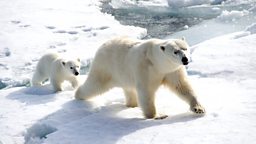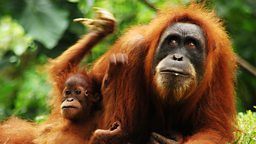Polar bears
- Polar bears mate on the sea ice in April or May, and cubs are born between late December and early January.
- The pregnant female survives the 7-8 months or fasting by using stored body fat – they may lose up to 40% of their body mass during this time.
- Newborn polar bears have no fat layer and short fur when they are born, so can’t emerge from the den until they can cope with the cold.
- By the time a cub leaves the den, it has grown to 10 kg in weight. It has thicker fur than a newborn, but still has very little subcutaneous fat.
- Small cubs survive the cold by having a high metabolic rate, fuelled by the fat content of mum’s milk.
- Polar bear milk is 31 to 35% fat. (Cow milk is 4% fat).
- Most cubs are nursed until they are two years old, though some are weaned after their first year. They are dependent on their mothers for their first two years – during this time they learn survival skills and hunting techniques.
- Polar bears can weigh 50% more at the end of the good season (seal hunting) than they do at the end of summer (lean times – seals out at sea).
- Polar bears put on most of their fat reserves between late April and mid-July.
- An average polar bear can consume 4.4 pounds of fat a day (2 kg of fat a day).
Why not eat the meat?
Fat is more energy rich that protein. So they eat the blubber, not the meat. To break down and digest large amounts of protein, you need to get rid of the excess nitrogen in the protein by peeing it out in your urine. However, to produce lots of urine, you have to drink lots of water.
eating too much meat in a cold climate is a bad idea for a bear – stick to the fat
There is no drinking water on the polar ice cap! To get drinking water the polar bears would have to eat snow, or eat specific bits of icebergs (sea ice and sea water are too salty and would make them thirstier than they started out). Eating snow or ice would lower the polar bear’s body temperature, which is not a good idea. For comparison, Inuit/Eskimo peoples’ traditional diet of seal and whale meat meant that they had to drink a lot of water. They got it by melting ice and snow in pots fuelled by seal oil.
So eating too much meat in a cold climate is a bad idea for a bear – stick to the fat.






